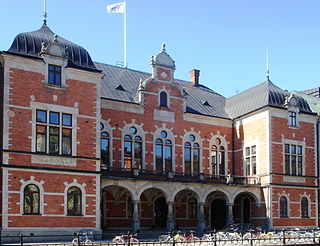
Dolichoderinae is a subfamily of ants, which includes species such as the Argentine ant, the erratic ant, the odorous house ant, and the cone ant. The subfamily presents a great diversity of species throughout the world, distributed in different biogeographic realms, from the Palearctic, Nearctic, Afrotropical region and Malaysia, to the Middle East, Australian, and Neotropical regions.

Amyrmex golbachi is a rare Neotropical species of ant and the only known species in the genus Amyrmex. It is currently only known from males from the Amazon basin of Brazil and from northern Argentina.

Norrlands nation is a student society and the largest of thirteen nations at Uppsala University. It mainly recruits its members from the province of Norrland, which is the northernmost part of Sweden. As of 2012, the nation has about 8,000 members.

Forelius damiani is a species of ant in the genus Forelius. It was discovered and described by Jack A. Oscarson in 2008.

Forelius is a Neotropical genus of ants in the subfamily Dolichoderinae. The genus is known from southern United States to Argentina.
Forelius albiventris is a species of ant in the genus Forelius. Described by Auguste-Henri Forel in 1912, the species is endemic to South America.
Forelius andinus is a species of ant in the genus Forelius. Described by Kusnezov in 195, the species is endemic to Argentina.
Forelius bahianus is a species of ant in the genus Forelius. Described by Cuezzo in 2000, the species is endemic to Brazil.

Forelius brasiliensis is a species of ant in the genus Forelius. Described by Forel in 198 the species is endemic to South America.
Forelius breviscapus is a species of ant in the genus Forelius. Described by Auguste-Henri Forel in 1914, the species is endemic to Argentina.
Forelius grandis is a species of ant in the genus Forelius. Described by Auguste-Henri Forel in 1912, the species is endemic to Argentina.
Forelius keiferi is a species of ant in the genus Forelius. Described by William Morton Wheeler in 1934, the species is endemic to Mexico.
Forelius lilloi is a species of ant in the genus Forelius. Described by Cuezzo in 2000, the species is endemic to Argentina.
Forelius macrops is a species of ant in the genus Forelius. Described by Kusnezov in 195, the species is endemic to Argentina.
Forelius maranhaoensis is a species of ant in the genus Forelius. Described by Cuezzo in 2000, the species is endemic to Brazil.

Forelius nigriventris is a species of ant in the genus Forelius. Described by Forel in 1912, the species is endemic to South America.

Forelius pruinosus, commonly known as the high noon ant, is a species of ant in the genus Forelius. Described by Roger in 1863, the species is endemic to North America and has been recently observed in Latin America.

Forelius pusillus is a species of ant in the genus Forelius. Described by Santschi in 1922, the species is endemic to South America.
Forelius rubriceps is a species of ant in the genus Forelius. Described by Gallardo in 1916, the species is endemic to Argentina.
Forelius rufus is a species of ant in the genus Forelius. Described by Gallardo in 1916, the species is endemic to Argentina and Bolivia.







